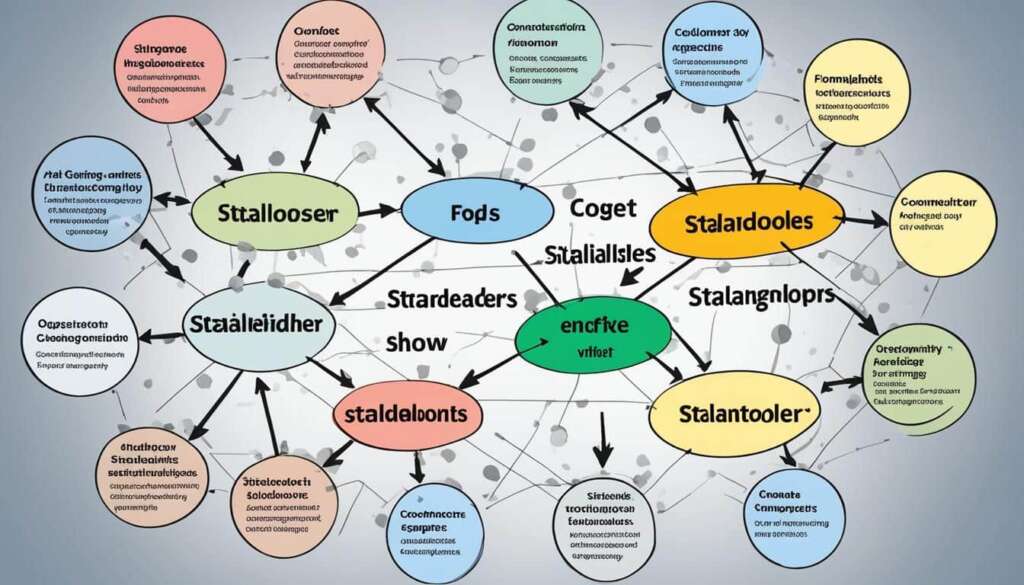Table of Contents
Stakeholders play a crucial role in the success of businesses and projects. They are individuals or organizations that have an interest in a company or project and can either affect or be affected by its operations and performance. Understanding the various stakeholder roles and their impact is essential for effective management and decision-making.
Stakeholders can have a significant influence on a company’s operations, reputation, and bottom line. They encompass a wide range of individuals and groups, including employees, customers, shareholders, investors, suppliers, and public communities. Each stakeholder has specific interests and expectations that need to be considered and addressed.
Defining Stakeholders and Their Interests
Stakeholders are individuals or groups who may be directly or indirectly affected by an effort or have a strong interest in it. Understanding the definition of stakeholders and their interests is crucial for effective management and decision-making. Stakeholders can be categorized into primary and secondary stakeholders based on the directness of their impact. Primary stakeholders are directly affected by the effort, while secondary stakeholders are indirectly affected.
Key stakeholders are individuals or groups who have the power to impact an effort or are important within the organization. They play a significant role in determining the success of businesses and projects. Recognizing and acknowledging their interests is essential for maintaining positive relationships and gaining support.
Stakeholder interests can vary widely, covering various aspects of their lives and the community. These interests encompass factors such as economics, social change, work, time, environment, physical health, safety and security, and mental health. Stakeholders’ interests can shape their expectations, priorities, and engagement levels with the effort.
Understanding stakeholders and their interests enables organizations to tailor their strategies and decisions to meet their needs effectively. It also helps in addressing potential conflicts and finding mutually beneficial solutions. By actively considering stakeholder interests, organizations can enhance their reputation, trust, and overall stakeholder satisfaction.
“The success of an effort relies on the understanding and engagement of stakeholders. By defining stakeholders and recognizing their interests, organizations can create a framework for effective collaboration and decision-making.”
The table below provides examples of stakeholder interests:
| Stakeholder Group | Interests |
|---|---|
| Employees | Job security, fair wages, work-life balance |
| Customers | Quality products/services, competitive prices, customer support |
| Investors | Maximizing returns, long-term profitability |
| Communities | Economic development, environmental sustainability, social well-being |
| Government | Compliance with regulations, tax revenue generation |
By identifying and understanding stakeholders and their interests, organizations can better align their efforts with stakeholder needs, foster collaboration, and achieve sustainable success.
Importance of Identifying and Analyzing Stakeholders
Identifying and analyzing stakeholders is a critical step in ensuring the success of any effort or project. By understanding who the stakeholders are and what their interests and concerns are, organizations can effectively engage them and make informed decisions that align with their needs and expectations.
When it comes to identifying stakeholders, it’s essential to consider both internal and external stakeholders. Internal stakeholders typically include employees, managers, and shareholders, while external stakeholders can be customers, suppliers, government agencies, and community organizations.
Analyzing stakeholders allows organizations to evaluate their influence, power, and potential impact on the project. This analysis helps prioritize stakeholders based on their importance and determine the level of engagement and communication needed.
Benefits of Identifying and Analyzing Stakeholders:
- Better Process: Involving stakeholders from the early stages of a project leads to a more inclusive and collaborative process. Their input and expertise can contribute to better decision-making and problem-solving.
- Greater Community Support: Engaging stakeholders fosters community support and trust. When stakeholders feel heard and involved, they are more likely to support and promote the project.
- More Ideas: Stakeholders bring different perspectives and knowledge to the table. By involving a diverse range of stakeholders, organizations can benefit from a wider pool of ideas and solutions.
- Better Understanding of Community Context: Analyzing stakeholders helps organizations gain insights into the local community and its needs, allowing them to tailor their efforts to the specific context and address any potential challenges.
- Fairness and Inclusivity: Engaging all relevant stakeholders ensures fairness and inclusivity in decision-making. It allows for diverse voices and perspectives to be heard, leading to more equitable outcomes.
- Avoiding Surprises or Opposition: Knowing who the stakeholders are and their interests can help organizations anticipate potential challenges or opposition and develop strategies to address them proactively.
- Strengthening the Organization’s Position: Building positive relationships with stakeholders enhances the organization’s reputation and credibility. It can also help strengthen partnerships and collaborations, leading to long-term success.
- Creating Bridging Social Capital: Engaging stakeholders builds bridging social capital within the community, fostering connections and relationships that can be valuable beyond the specific project or effort.
“Effective stakeholder identification and analysis sets the foundation for successful stakeholder management. It ensures that organizations consider the interests, needs, and concerns of those who can influence or are affected by their actions.”
Understanding stakeholder interests is crucial for gaining their buy-in, support, and credibility. It allows organizations to address their concerns and align their efforts with their expectations. By actively involving stakeholders in decision-making processes, organizations can create a sense of ownership and foster a collaborative approach.
Example Stakeholder Analysis Table:
| Stakeholder | Influence | Power | Interests/Concerns |
|---|---|---|---|
| Employees | High | High | Job security, fair compensation, work-life balance |
| Customers | Medium | High | Quality products, value for money, excellent customer service |
| Suppliers | Medium | Medium | Timely payments, long-term partnerships |
| Community Organizations | Low | Low | Environmental sustainability, social impact |

Note: This table provides a simplified example and does not reflect the complexities of real stakeholder analysis. In practice, organizations may use more in-depth assessments and engage stakeholders directly to understand their interests and concerns.
Who Are Potential Stakeholders?
Potential stakeholders refer to a wide range of individuals and groups who can have a significant impact on a business. They include:
- The beneficiaries or targets of the effort, such as specific populations or residents of a geographic area.
- People who are experiencing or at risk for a particular problem.
- Participants in particular organizations or institutions.
Furthermore, potential stakeholders encompass individuals and organizations directly involved with or responsible for the beneficiaries or targets. These can include service providers or regulatory bodies.
Identifying and understanding the different types of stakeholders is vital for organizations in order to gain insights into the various perspectives and interests involved. This enables businesses to effectively engage and manage stakeholder relationships while aligning their goals with the needs of their stakeholders.
Potential Stakeholders
| Beneficiaries | Participating Organizations |
|---|---|
| Specific populations | Service providers |
| Residents of a geographic area | Regulatory bodies |
| People experiencing or at risk for a particular problem |
The table provides a visual representation of potential stakeholders in a business context. It highlights the different categories of beneficiaries, such as specific populations and residents of a geographic area, as well as participating organizations, which can include service providers and regulatory bodies.
Understanding Stakeholders in Business
Stakeholders are vital players in the world of business, encompassing individuals and groups who have a vested interest in a company’s operations and outcomes. They can either directly impact or be influenced by the organization. By recognizing and engaging stakeholders, businesses can effectively manage their needs and expectations and make informed decisions to address conflicting interests. Let’s explore the different types of stakeholders and the concept of stakeholder capitalism.
Internal and External Stakeholders
Stakeholders in business can be classified as either internal or external to the organization. Internal stakeholders maintain a direct relationship with the company, consisting of employees, owners, and investors. They contribute to the everyday functioning of the business and hold a vested interest in its success. On the other hand, external stakeholders are not directly involved with the company’s operations but are still affected by its actions. This includes suppliers, creditors, and public groups.
Stakeholder Capitalism
Stakeholder capitalism is a philosophy that places equal importance on all stakeholders involved in a business, beyond solely prioritizing shareholders. This system acknowledges the impact of business decisions on employees, customers, communities, and the environment. By considering the interests of all stakeholders, corporations can foster trust, social responsibility, and sustainable long-term growth.
“The well-being of stakeholders is intrinsically linked to the success of the business. A strategy that addresses the needs of shareholders, employees, customers, and communities is crucial for long-term growth and profitability.”
Understanding the role of stakeholders in business is crucial to effective decision-making and ensuring harmonious relationships. By acknowledging and addressing the needs of all stakeholders, organizations can build trust, loyalty, and resilience, ultimately contributing to their overall success.
| Key Stakeholders | Role and Influence |
|---|---|
| Shareholders and Investors | Financially invested in the company and often involved in decision-making processes. |
| Employees | Contribute to the success of the business through their work and influence customer satisfaction. |
| Customers | Provide the necessary revenue for the business and influence its reputation through their experiences. |
| Suppliers and Business Partners | Affected by the company’s operations and have a significant influence on its success. |
The Effects of Stakeholders on Business
Stakeholders have a significant impact on businesses, both financially and socially. Their involvement and expectations can directly influence a company’s bottom line, shaping its financial performance and outcomes. Moreover, stakeholders such as consumers, communities, employees, and business partners hold the power to shape a company’s reputation and operations, thus affecting its overall success and sustainability.
Managing relationships with stakeholders is crucial for businesses to strike a balance between profitability and social responsibility. By understanding and addressing the needs and expectations of various stakeholders, businesses can create a harmonious environment that meets the demands of diverse stakeholders while maximizing their own interests.
The Financial Implications of Stakeholders
Stakeholders wield significant financial influence over businesses. Their expectations and actions can directly impact a company’s financial performance, growth, and investment opportunities. For example, shareholders and investors influence businesses through their investment decisions, which can impact stock prices, access to capital, and the ability to attract future investment.
Additionally, stakeholders’ involvement in a company’s operations and decision-making process affects financial outcomes. Collaborating with stakeholders to drive innovation, improve efficiency, and align business strategies can lead to increased profitability and sustainable growth.
The Social Impact of Stakeholders
Stakeholders extend beyond financial implications and possess the power to shape a company’s social reputation and impact. The perceptions and actions of stakeholders such as consumers, communities, employees, and business partners can influence a company’s public image, customer loyalty, and market position.
Consumers, in particular, have become more conscious about supporting businesses that align with their values and social responsibility. Positive stakeholder relationships can enhance a company’s brand reputation, attract customers, and foster consumer trust and loyalty. On the other hand, negative stakeholder perceptions or actions can lead to reputational damage, reduced consumer support, and potential boycotts.
Similarly, employees and communities play a vital role in shaping a company’s social impact. Employees who feel valued and have a sense of purpose are more engaged and productive, positively impacting the company’s operations and bottom line. Engaging with local communities and addressing their needs and concerns fosters goodwill, social cohesion, and positive relationships, further enhancing a company’s social impact.
By effectively managing relationships with stakeholders, businesses can navigate potential conflicts, mitigate risks, and capitalize on shared interests. Organizations that prioritize stakeholder engagement and address their concerns are better equipped to adapt to evolving market dynamics, enhance competitiveness, and create sustainable, long-term value for all parties involved.
Key Stakeholders in Business
Key stakeholders play a critical role in the success and operations of a business. They are individuals or groups that have a vested interest in the company and its activities. Understanding who these key stakeholders are is essential for effective decision-making and strategic planning.
Shareholders and Investors: Shareholders and investors are vital stakeholders in a company. They hold financial stakes in the business and expect a return on their investments. Shareholders often have voting rights and can influence the direction and decisions of the company.
Employees: Employees are another key stakeholder group. They contribute their skills, expertise, and effort to the success of the company. Employee satisfaction and engagement play a crucial role in driving productivity, customer satisfaction, and overall business performance.
Customers: Customers are essential stakeholders as they provide the necessary revenue for the business. Meeting customer needs and delivering value is crucial for customer retention and business growth. Understanding customer preferences and feedback is vital for maintaining a competitive edge in the market.
Suppliers and Business Partners: Suppliers and business partners also play a significant role in the operations and success of a company. They provide essential resources, materials, and services that enable the business to function effectively. Building strong relationships and ensuring mutually beneficial partnerships is key to long-term success.
“Key stakeholders in a business include shareholders, investors, employees, customers, and suppliers.”
Building Effective Relationships with Stakeholders
Building and maintaining effective relationships with stakeholders is crucial for the long-term success of a business. In order to do so, it is important to understand the needs, expectations, and concerns of stakeholders. By aligning the organization’s goals with those of the stakeholders, a strong foundation can be established for collaboration and cooperation.
Open communication plays a vital role in building effective relationships. By fostering an atmosphere of transparency, stakeholders can feel valued and heard, and the organization can gain important insights and feedback. Regularly engaging in meaningful dialogue with stakeholders helps ensure that their interests are acknowledged and considered, leading to mutual trust and respect.
Furthermore, it is essential to actively involve stakeholders in decision-making processes. By giving them a voice and actively addressing their interests, businesses can demonstrate their commitment to stakeholder engagement. This not only strengthens support and loyalty but also promotes a sense of ownership and shared responsibility.
Ultimately, building effective stakeholder relationships requires a focus on mutual benefit. By identifying areas of collaboration and working towards shared goals, businesses can foster long-lasting partnerships that drive success. By prioritizing stakeholder management, organizations can enhance their reputation, mitigate risks, and create a positive impact in the larger community.
FAQ
What are stakeholder roles and how do they impact a company or project?
Stakeholder roles refer to the individuals or organizations that have an interest in a company or project and can either affect or be affected by its operations and performance. These stakeholders play a crucial role in the success of businesses and projects, and their impact can be significant.
How are stakeholders defined and what are their interests?
Stakeholders are those who may be directly or indirectly affected by an effort or have a strong interest in it. They can be categorized into primary stakeholders, who are directly affected by the effort, and secondary stakeholders, who are indirectly affected. Stakeholder interests can vary widely and include factors such as economics, social change, work, time, environment, physical health, safety and security, and mental health.
Why is it important to identify and analyze stakeholders?
Identifying and analyzing stakeholders is crucial for the success of any effort or project. It allows for the recruitment of stakeholders as part of the effort, leading to a better process, greater community support, more ideas, and a better understanding of the community context. It also ensures fairness and inclusivity, saves from surprises or opposition, strengthens the organization’s position, and creates bridging social capital in the community.
Who are potential stakeholders?
Potential stakeholders can include beneficiaries or targets of the effort, such as specific populations, residents of a geographic area, people experiencing or at risk for a particular problem, and participants in particular organizations or institutions. They can also include those directly involved with or responsible for the beneficiaries or targets, such as individuals and organizations providing services. Identifying the different types of stakeholders helps organizations understand the various perspectives and interests involved.
How should stakeholders be understood in a business context?
In a business context, stakeholders can be internal or external to the organization. Internal stakeholders have a direct relationship with the company, such as employees, owners, or investors. External stakeholders are not directly involved with the company but are affected by its actions, such as suppliers, creditors, and public groups. Understanding the role of stakeholders in business is essential for effective decision-making and addressing conflicting interests.
What effects do stakeholders have on a business?
Stakeholders can have both financial and social implications on a business. Financially, stakeholders can impact the company’s bottom line through their involvement and expectations. Socially, stakeholders such as consumers, communities, employees, and business partners can influence the reputation and operations of a business. Managing relationships with stakeholders is crucial to balancing profitability, social responsibility, and meeting the needs and expectations of various stakeholders.
Who are the key stakeholders in a business?
Key stakeholders in a business include shareholders, investors, employees, customers, and suppliers. Shareholders and investors have a financial interest in the company’s success and often play a significant role in decision-making. Employees contribute to the success of the company through their work and can have a direct impact on customer satisfaction. Customers are crucial stakeholders as they provide the necessary revenue for the business. Suppliers and business partners also have a significant influence on the operations and success of a company.
How can effective relationships with stakeholders be built?
Building and maintaining effective relationships with stakeholders is essential for the long-term success of a business. This involves understanding their needs, expectations, and concerns, and aligning the organization’s goals with those of the stakeholders. Open communication, transparency, and mutual benefit are key factors in establishing positive relationships. By actively involving stakeholders in decision-making and addressing their interests, businesses can strengthen their support, loyalty, and overall success.












